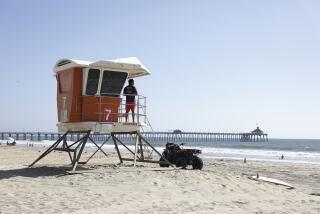Safety Threats Abound on Playgrounds, Study Reveals
- Share via
Public playgrounds, including some in San Diego County, possess hidden hazards that threaten the safety of the nation’s children, according to a report released Thursday by a pair of consumer groups.
“We found, unfortunately, many dangers posed by public playgrounds that children are facing,” said Jeffrey Francis, consumer program director for the California Public Interest Research Group.
Nationally, 17 children die yearly from injuries suffered at public playgrounds, and nearly another 150,000 are injured seriously enough to require emergency room treatment, Francis said.
The survey by CalPIRG and the Consumer Federation of America examined 130 playgrounds from a dozen states, including randomly selected playgrounds in San Diego County.
Those included Doyle Elementary School in La Jolla, Bay Ridge Town Homes near Golden Hill, La Jolla Recreation Center, Ocean Beach Park, Ocean Beach Elementary School, Dusty Rhoades Park in Ocean Beach, Wells Park in El Cajon, Prospect Avenue School in Santee, Sequoia Elementary School in Clairemont and Lindbergh Park in Clairemont.
A lack of safe surfacing topped the list of playground dangers, which is significant because an estimated 75% of all playground injuries are caused by falls, Francis said. Nationwide, 88% of the playgrounds surveyed lacked adequate surfacing, with San Diego County’s playgrounds faring slightly better with 73% lacking.
To ensure that surfaces are safe, 9 to 12 inches of shock-absorbent material such as wood chips or sand should be used to top playgrounds, Francis said.
Children were also at risk of strangling themselves at 58% of the playgrounds because of inadequately spaced equipment, Francis said. Again San Diego County fared slightly better than the national average, with 46% of the 11 playgrounds surveyed posing such threats.
Bars spaced between 3 and 9 inches posed the most threat, said Francis as he demonstrated how a child’s head could become caught in a piece of equipment.
Inadequately spaced swings also posed threats to a child’s head and face at 78% of the 103 playgrounds surveyed in 12 states and the District of Columbia. In San Diego, 40% of 10 playgrounds surveyed had insufficient spacing.
Safe spacing, said Francis, requires that swings be at least 2 feet from each other and 2 1/2 feet from the support bars.
The study surveyed playgrounds in Arizona, California, Colorado, Connecticut, Florida, Maryland, Massachusetts, New Jersey, Oregon, Virginia, Washington, Wisconsin and the District of Columbia.
The consumer groups now hope individual states and cities will adopt safety guidelines for playground equipment written by the Consumer Federation, Francis said. Manufacturers now are only obliged to acknowledge a set of safety recommendations issued by the U.S. Consumer Products Safety Commission.
More to Read
Sign up for Essential California
The most important California stories and recommendations in your inbox every morning.
You may occasionally receive promotional content from the Los Angeles Times.













